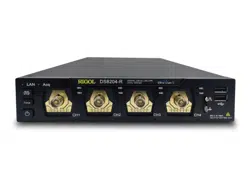Loading ...
Loading ...
Loading ...

Chapter 5 To Trigger the Oscilloscope RIGOL
DS8000-R User Guide 5-5
Click on the trigger setting label at the upper-right corner of the
screen. Then the following window is displayed. Click to select "Auto", "Normal", or
"Single" as the trigger mode.
Note: In "Normal" and "Single" trigger modes, press Force on the front panel to
generate a trigger signal forcibly.
Trigger Coupling
Trigger coupling decides which kind of components will be transmitted to the trigger
module. Please distinguish it from "Channel Coupling".
Note: Trigger coupling is only valid when the trigger type is Edge and the trigger
source is an analog channel.
In the "Trigger" menu, click Coupling to select the desired coupling mode.
DS8000-R provides four coupling mode: DC, AC, LFR, and HFR. By default, it is DC.
⚫ DC: allows DC and AC components to pass the trigger path.
⚫ AC: blocks the DC components and attenuates signals.
⚫ LFR: blocks the DC components and rejects the low-frequency components.
⚫ HFR: rejects the high frequency components.
Trigger Holdoff
Trigger holdoff can be used to stably trigger on complex repetitive waveforms that
have multiple edges (or other events) between waveform repetitions (such as pulse
series). Holdoff time indicates the time that the oscilloscope waits for re-arming the
trigger module after generating a correct trigger. The oscilloscope will not trigger
even if the trigger condition is met during the holdoff time and will only re-arm the
trigger module after the holdoff time expires.
Tip
When "AC" or "LFR" is selected under Coupling, no trigger level lines and trigger
icons are displayed. When you adjust the trigger level, you can only see the
changes of the trigger level values at the upper-right corner of the screen.
Loading ...
Loading ...
Loading ...
